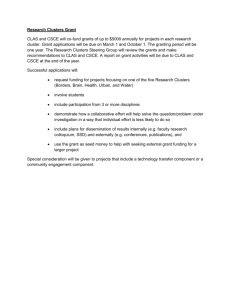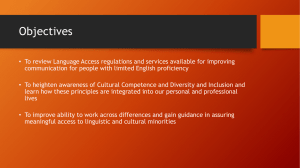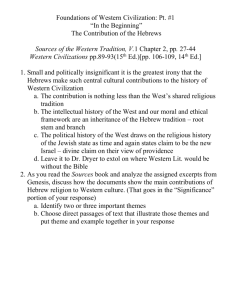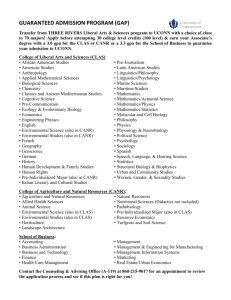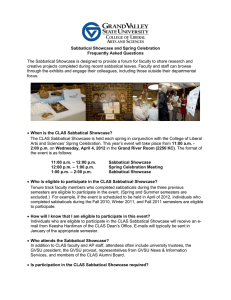A Tradition of Change - Grand Valley State University
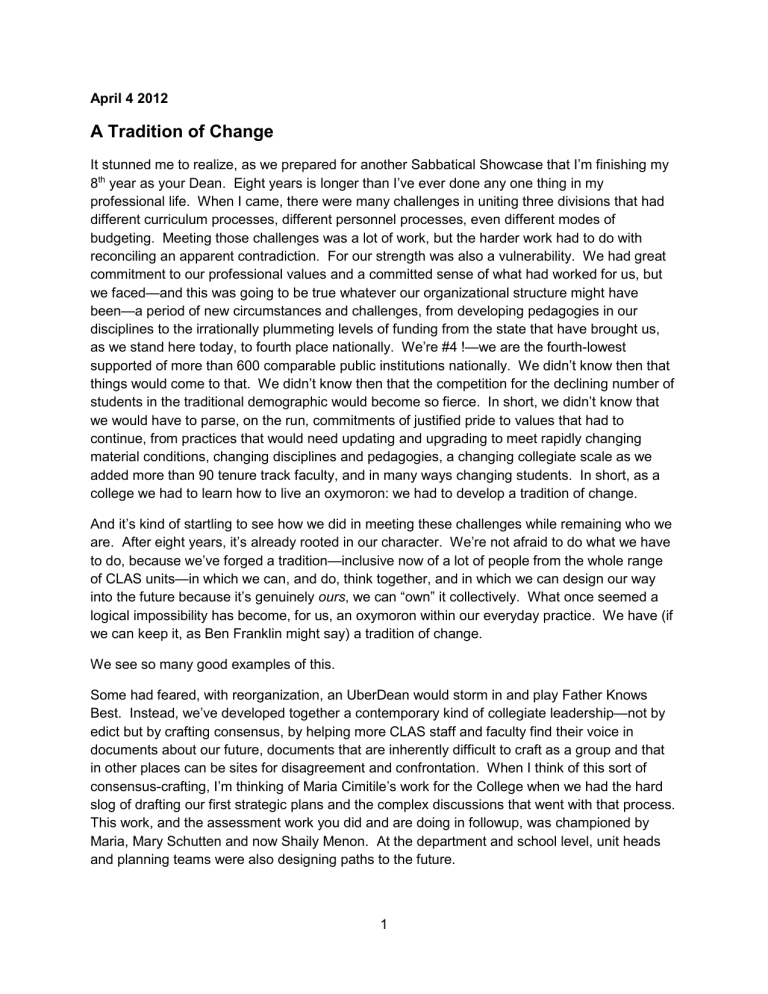
April 4 2012
A Tradition of Change
It stunned me to realize, as we prepared for another Sabbatical Showcase that I’m finishing my
8 th year as your Dean. Eight years is longer than I’ve ever done any one thing in my professional life. When I came, there were many challenges in uniting three divisions that had different curriculum processes, different personnel processes, even different modes of budgeting. Meeting those challenges was a lot of work, but the harder work had to do with reconciling an apparent contradiction. For our strength was also a vulnerability. We had great commitment to our professional values and a committed sense of what had worked for us, but we faced —and this was going to be true whatever our organizational structure might have been —a period of new circumstances and challenges, from developing pedagogies in our disciplines to the irrationally plummeting levels of funding from the state that have brought us, as we stand here today, to fourth place nationally. We’re #4 !—we are the fourth-lowest supported of more than 600 comparable public institutions nationally. We didn’t know then that things would come to that. We didn’t know then that the competition for the declining number of students in the traditional demographic would become so fierce. In short, we didn’t know that we would have to parse, on the run, commitments of justified pride to values that had to continue, from practices that would need updating and upgrading to meet rapidly changing material conditions, changing disciplines and pedagogies, a changing collegiate scale as we added more than 90 tenure track faculty, and in many ways changing students. In short, as a college we had to learn how to live an oxymoron: we had to develop a tradition of change.
And it’s kind of startling to see how we did in meeting these challenges while remaining who we are. After eigh t years, it’s already rooted in our character. We’re not afraid to do what we have to do, because we’ve forged a tradition—inclusive now of a lot of people from the whole range of CLAS units —in which we can, and do, think together, and in which we can design our way into the future because it’s genuinely ours , we can “own” it collectively. What once seemed a logical impossibility has become, for us, an oxymoron within our everyday practice. We have (if we can keep it, as Ben Franklin might say) a tradition of change.
We see so many good examples of this.
Some had feared, with reorganization, an UberDean would storm in and play Father Knows
Best. Instead, we’ve developed together a contemporary kind of collegiate leadership—not by edict but by crafting consensus, by helping more CLAS staff and faculty find their voice in documents about our future, documents that are inherently difficult to craft as a group and that in other places can be sites for disagreement and confrontation. When I think of this sort of consensuscrafting, I’m thinking of Maria Cimitile’s work for the College when we had the hard slog of drafting our first strategic plans and the complex discussions that went with that process.
This work, and the assessment work you did and are doing in followup, was championed by
Maria, Mary Schutten and now Shaily Menon. At the department and school level, unit heads and planning teams were also designing paths to the future.
1
Meanwhile Figen Mekik and George McBane were using many, many direct consultations with faculty in setting up strong, efficient personnel procedures. Ed Aboufadel and Jodee Hunt and
Grace Coolidge were creating a CLAS Faculty Council that produces creative, truly out-of-thebox results for faculty. Matt Boelkins and Steve Matchett made faculty development a key priority of the College, and something we do exceptionally well. A whole series of curriculum leaders including now-Associate Dean Mary Schutten and her dedicated successor Carolyn
Shapiro-Shapin helped make the process clearer, simpler, and as a result more substantive even as the pace of curriculum change accelerated. The newest chairs of our elected committees frequently tell me that they appreciate what was developed for them to inherit — because, in the way traditions begin to get traction, those developments set the bar progressively higher for future governance work.
Betty Schaner and her team in our advising center have created workable processes that often become the basis for whole-university adoption, and our unit heads supported her very usefully in that. I wish there was a way of publically accounting for the problems that don’t happen because of Betty and her team’s leadership. And when the temperature rises or a flood gushes in, I find myself very thankful for the caliber of the people —from Sandy Bacon to Aaron Perry and Jim Seufert —working to keep us safe, make our instruments work, and solve these problems.
Shaily calls this distributed leadership. I might add that leadership in our College is also collective, collaborative, and accountable. Our strength —and I find this unmatched in the
University —is in our connections to one another, not in fortifications against change. We have no administrative moats distancing and muddying accountability; we have people who take risks to develop their leadership, and take responsibility for its results.
What we have done is the best index of what we can do —and looking back as well as forward, we know we can do amazing things. At our best, we are not pressed into change by circumstance or trends or “management” by an UberDean; together, we recognize needs as they emerge here on the ground; and —not without nostalgia for what might have gone before, but not immobilized by it either —we set out in our own direction, and lead the change.
I would offer as examples characteristic of CLAS the research clusters that we started this year, clustered on Water, Urban, Borders, Brain and Health. They are a good representation and extension of our character, and we have high hopes that they will generate even more creative collaboration within CLAS and with colleagues from other colleges who have been keen to join our discussions. Our office is finding ways to support these clusters with local and timely information about opportunities to share ideas, relevant grant announcements, and explorations of resource sharing —and a few cookies. The signs are very good. Already we are seeing in the Brain research cluster discussions between Psychology and Chemistry Ed faculty and facility tours, and there are plans including a collaborative colloquium or mini-conference of research presentations. Researchers in the Water cluster submitted the Haiti grant to NSF, and led by Anthropologist Azizur Molla, are working on submitting a revised and expanded proposal including water quality in Bangladesh. The Borders group is planning a themed colloquium.
The Health cluster is exploring ways of monitoring inflammatory markers in cold water
2
immersion therapy to shorten recovery time after exercise-induced muscle injury. The Urban cluster participated in a web conference on Building Collaborative Funding Capacity. This is not an exhaustive list of their activities, only highlights, but you get the idea. These clusters exploit a strength inherent in a college as diverse and interdisciplinary and fundamentally collaborative as CLAS. In a short time, these groups from multiple disciplines found ways to connect and grow together.
Th ere are many other signs of CLAS’s capacity to work in new ways. Look at what you’ve managed just in recent weeks: you’re working very hard on changes in teacher training to keep up with the ever-moving target of state standards, and are making real headway. When
Omicron Delta Kappa, a national leadership honor society, celebrated the 20th year of the
GVSU chapter, 20 distinguished faculty were named; 15 of those were from CLAS. Kingshuk
Majumdar of Physics learned that he has been awarded supercomputing time to work on the project "Quantum phases of frustrated magnetic spin systems." What I love most about that title is the frustrated spin systems. Chemistry brought a rare laurel to campus: Brad Walla r’s student
Brianne Docter won a Goldwater , big news because it’s only our second one after Kyle
Schneider from Dave Leonard’s chem lab four years ago. Our dancers participated in a very special event this term that harnessed the talents of 5 universities. Several of you were sought out to comment on our nation’s politics—for example Poli Sci’s Erika King’s comments about
Mitt Romney were picked up by the international media for many days after her initial local interview. Danielle Leek from the School of Comm was interviewed on employer-employee communication —and in her free time is bringing up to speed Grand Valley’s first Speaking Lab, sure to be a great resource for our teaching. Biology’s Erik Nordman will be a Fulbright Scholar in Kenya this summer. In other words, our faculty were sought out to explain or exemplify everything from nano-particles to national politics, from aging industries to interoffice age-gaps, from collaborative dance to colleagues of distinction.
Which brings me back to our Spring Celebration and Sabbatical Showcase. Our largest
Showcase yet, we have assembled the fruits of great labor, expertise and creativity. You can honor that work by finding your own connections; as we wander among the exhibits, we witness the fruits of labor, significant finished products; but we also, and perhaps even more importantly, are in the midst of enormous and available potential. In the next room may be, in someone else’s work, the prospect of a great collaboration for you, one as yet inconceivable while you sit here finishing your lunch. It is our tradition that we would find ways of extending that potential, by sharing it with appropriate audiences, and by discovering ways in which to engage it with our community, and perhaps involve additional students. My hope for this day every year is that there are people in the room who will find unanticipated openings to take advantage of, and every year my hope is fulfilled.
So let’s think of our Showcase—electric with ideas, midwifing scholarship, and most of all visibly enriching teaching —as a mile marker of where we are going. At this time last year I said to you,
“we have been fighting the fight resourcefully, and CLAS had a wonderful year in 2010-11; but
[…] conditions change, and we may need to change with them.” This year and for eight years, you have. In the short time that we have been a college, we’ve navigated unpredictable change
3
while, in the process, establishing a stable tradition with a distinctive commitment to our students.
In that context I’d like to call to your attention a specific threat and a general problem with which we must deal in the coming years. The specific threat is simple and clear. As many of you know, from 2010 to 2019 the traditional college-age population in Michigan drops by almost 17 percent. Of course anything approaching that kind of drop-off in undergraduate students would be a disaster for all the progres s we have made. I don’t think that’s imminent, we will remain an attractive institution even as we compete with richer institutions, but we must be vigilant, and vigilance will often require agility and adaptiveness. Creating new programs, updating old ones, having the courage to sunset what no longer works to free up resources with which to create, and supporting new programs in other areas like health professions and education will be necessary; so will developing our sensitivity to the needs of different kinds of students, including transfers, non-traditionals and veterans, who may be taking a larger number of seats in our classes.
Connected to that is a general problem that afflicts all institutions of higher education in
Michigan, and to some extent in all of the states. Students are graduating with more and more debt. When I left Iowa, the figure there was around $6,000. But now, students who graduate from Grand Valley with debt (about 70% of them) average more than $25,000 in debt. As state support has withered and tuition has had to rise, this figure has jumped upward. Frustrating as it may be, irrational as it is, i t’s not in our immediate power to make a state that needs more college graduates see the wisdom in investing in its young people. But there are things we can do. We can untangle unnecessary complications and remove obstacles from the path of students who intend to graduate on time. In our advising, we can expect ourselves and each other to keep up to date with the requirements of the major and of Gen Ed as they change. It’s still true that fewer than a quarter of our students graduate in four years, and that duration is a powerful cause of postgraduation debt. We can examine our text requirements, be aware of book prices and their increases, and make ourselves aware of more affordable text alternatives that would serve the curricular purpose as well; in any one course, it may be a small matter, but over 40 or more courses in pursuit of a degree, savings add up. And we can encourage our students . Please don’t forget the motivating force you can supply by expressing personal interest in their persistence, progress and success.
These challenges, and doubtless many more that we can’t foresee, await us. But we have reasons for confidence, many of them on display in the Grand River Room. Today is the intersection of celebrating what we have been, and renewing our commitment to each other to grow and change as we must. We must meet, in the tradition of those who came before us who have met, the challenge of preserving our values faithfully as circumstances change, by adapting and extending —and thereby affirming—our tradition.
To day we can say that we’ve fulfilled that duty, and have founded together a tradition that generates products of the quality and rang e we see in this year’s Sabbatical Showcase, the largest we’ve ever had. The force of our community and our accomplishments this year tell us we can continue to embrace the oxymoron of being rooted firmly in nimble motion forward.
4
You’ll see a lot of great things in the Showcase today; we’ll see some more challenges down the line. But here’s how, after our eight years, we can think about ourselves: in CLAS, we stand— and move —in a confident, collaborative, mindful of external traditions but not distracted by them, past-appreciating but forward-looking tradition of change.
5
